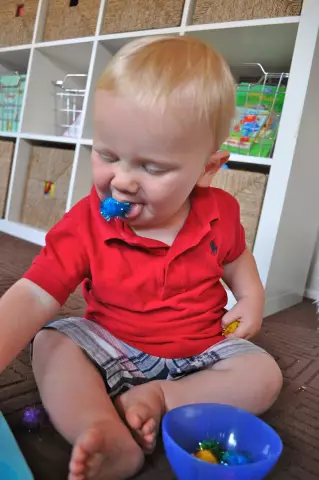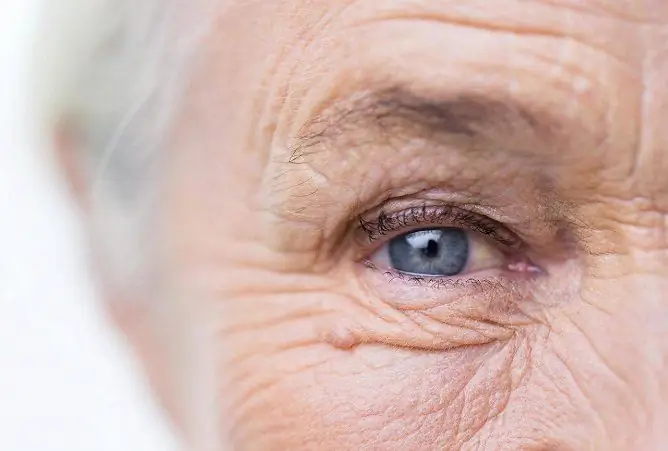- Author Rachel Wainwright [email protected].
- Public 2024-01-15 19:51.
- Last modified 2025-11-02 20:14.
Pressure in a child: the norm of child pressure by age, deviations, measurement features
The content of the article:
- What is blood pressure?
- Normal blood pressure in children
- Features of blood pressure measurement in children
- What to do if the pressure deviates from the norm
- Video
The norm of pressure in a child should be known not only to specialists, but also to parents, because the indicator of blood (arterial) pressure is very important, as it allows assessing the state of the cardiovascular system and its functioning.

Before measuring the pressure, the child must be at rest for some time, otherwise the indicators will be falsely overestimated
What is blood pressure?
At the moment of contraction of the heart (systole), blood is forcefully thrown into the arterial network and at the same time exerts a certain pressure on the walls of the vessels. The magnitude of this force, acting on a unit area of the inner surface of the vascular wall, is called arterial pressure (BP). The value of blood pressure and pulse rate are the main indicators of hemodynamics.
Blood pressure is recorded in the form of two numbers, separated by a fraction line. The first number indicates the systolic (upper) pressure, which is directly related to the strength of the heartbeat. The second number is the value of diastolic (lower) pressure, determined by the tone of the blood vessels.
Normal blood pressure in children
Another founder of the Russian pediatric school, professor S. F. Hotovitsky wrote: "A child is not a reduced copy of an adult; a child is a creature that grows and develops only according to its inherent laws." It really is. For example, the younger the child, the more extensive and pronounced his capillary network, the wider the lumen of the blood vessels and the more elastic their walls. All these factors contribute to the fact that blood pressure in infants is significantly lower than in adults, and gradually increases as they get older.
The rate of child pressure depends not only on age, but also on gender. Until the age of five, the value of blood pressure is practically the same in girls and boys. From 5 to 8 years old, the pressure in girls becomes slightly lower than that of boys.
To calculate the normal (proper) blood pressure in children of different age groups, doctors use special formulas:
- Systolic blood pressure in children under one year old is (2n + 76), where n is the number of months of life. For example, for a child aged three months, the normal systolic pressure would be: (2 x 3 + 76) = 82 mm Hg. Art.
- Systolic blood pressure in children from 1 to 15 years old is (2n + 90), where n is the number of years. Let's calculate the rate of systolic pressure for a 5-year-old child: (2 x 5 + 90) = 100 mm Hg. Art.
- Diastolic pressure in children from birth to 12 months - from 2/3 to 1/2 of the maximum value of systolic pressure. That is, for a 4-year-old child, the maximum systolic pressure is 98 mm Hg. Art., and diastolic is in the range from 49 to 65 mm Hg. Art.
- Diastolic pressure from 1 year to 15 years - (n + 60), where n is the number of full years. For an eight-year-old child, the maximum diastolic pressure according to this formula is 68 mm Hg. Art.
In order, for example, to determine what pressure a 9-year-old child should have, you can use special tables, which indicate the normal indicators of systolic and diastolic pressure, pulse rate.
Table "Norm of blood pressure in children by age"
| Blood pressure in mmHg Art. | Heart rate (beats per minute) | |||
| Systolic | Diastolic | Mean | Limit values | |
| From birth to 1 month | 60-80 | 96-112 | 140 | 110-170 |
| From 1 month to 1 year | 90-112 | 50-74 | 130 | 102-162 |
| 1-3 years | 100-112 | 60-74 | 115 | 90-140 |
| 4 years - 5 years | 100-116 | 60-76 | 106 | 86-126 |
| 6-10 years old | 100-122 | 60-78 | 92 | 68-108 |
| 11-12 years old | 110-126 | 70-82 | 80 | 60-100 |
| 13-15 years old | 110-136 | 70-86 | 75 | 55-95 |
It should be understood that the value of blood pressure is not constant and is influenced by various factors and, above all, physical activity. Under their influence, the need for organs and tissues for oxygen and nutrients increases. This leads to the fact that the heart begins to contract with a greater frequency and intensity, which becomes the cause of a temporary increase in blood pressure and an increase in heart rate. In healthy children, these indicators return to normal after a short rest.
In young children, many diseases of the respiratory system (pneumonia, bronchiolitis, false croup), especially if treatment is not started on time, can be complicated by the development of respiratory failure (rapid breathing, cyanosis of the skin and mucous membranes, weakness). In this pathological condition, due to poor oxygenation, blood is retained in the vessels of the small (pulmonary) circulation, as a result of which hypotension (low pressure) develops in the systemic circulation.
Features of blood pressure measurement in children
The result will depend on how correctly the blood pressure measurement is made.
It is advisable to carry out the procedure in the morning, 15-20 minutes after waking up. It should not be performed immediately after eating, bathing or active play. If the child is agitated, then he should be reassured and try to divert his attention, as otherwise the indicators will be overestimated. If a child is prescribed nasal or ocular vasoconstrictor drops, they should be used no later than 60 minutes before the blood pressure measurement.
It is unacceptable to use tonometer cuffs intended for adults in pediatric practice. The choice of the cuff is determined by the age of the child:
- children of the first year of life - 7.0 x 3.5 cm;
- children of the second year of life - 9.0 x 4.5 cm;
- from 2 to 4 years old - 11.0 x 5.5 cm;
- from 4 to 7 years old - 13.0 x 6.5 cm;
- from 7 to 10 years old - 15.0 x 8.5 cm;
- 10 years and older - standard cuff sizes.
It is most convenient to measure blood pressure using modern electronic tonometers. But it is perfectly acceptable to use an ordinary tonometer with a phonendoscope. In the latter case, the procedure is performed in the following sequence:
- The child is given a position comfortable for the procedure. Infants are placed on their backs on a flat, horizontal surface. For children 2 years of age and older, the measurement is usually taken while sitting.
- The arm is wrapped with a cuff and positioned so that the elbow joint is at the level of the heart. The lower edge of the cuff should not reach the upper edge of the cubital fossa by 2-3 cm.
- Palpation determines the place of pulsation of the brachial artery in the ulnar fossa and applies the head of the phonendoscope to it.
- With the help of a pear, air is pumped into the cuff. It is necessary to create a pressure in the cuff of 20-25 mm Hg. Art. more than systolic (that is, the one at which the pulse wave disappears).
- The valve is slightly opened and air is released very slowly, following the tonometer scale and noting the appearance of the first tone (corresponds to systolic pressure) and the last tone (corresponds to diastolic pressure).
- The measurement should be repeated three times with an interval of 5 minutes.
What to do if the pressure deviates from the norm
We found out how many times it is necessary to measure and what the pressure rate should be, depending on the child's age. Unfortunately, children, as well as adults, often have various variants of deviations from this norm. High blood pressure is called hypertension, and low blood pressure is called hypotension (hypotension).
Deviation of blood pressure from the norm is usually manifested by the following symptoms:
- headache;
- weakness;
- nausea;
- noise in ears.
However, children of the younger age group, due to their age and insufficiently well-developed speech skills, cannot always inform their parents about their discomfort. You can suspect hypertension or hypotension in them by the following signs:
- headache complaints;
- violations of coordination of movements;
- drowsiness;
- fast fatiguability;
- fainting;
- transient visual impairment;
- convulsions, paresis.
If one or more of the listed symptoms appear, the child should definitely be consulted with a pediatrician to measure his blood pressure.
If both or one parent has arterial hypertension, then the child also has a risk of increased blood pressure. Therefore, such children are advised to periodically measure their blood pressure, regardless of the presence or absence of any clinical manifestations of hypertension.

Hypertension in a child is manifested by a headache
Hypotension in a child is often considered by doctors as a variant of the norm, subject to general good health. Low blood pressure is often observed in children who are actively involved in sports.
If a child has a single high blood pressure, this is not the basis for a diagnosis of hypertension. The obtained indicators may be overestimated as a result of the child's emotional lability, his high physical activity shortly before the measurement.
In this case, the doctor may recommend daily monitoring of blood pressure at home. The indications for this study are presented in the table.
| Indications | The reasons |
| Identification and confirmation of arterial hypertension | Any kidney disease, condition after transplantation (kidney, liver or heart), type I diabetes mellitus, confirmation of the diagnosis before starting antihypertensive therapy |
| During therapy | Evaluation of the effectiveness of treatment, timely detection of cases resistant to antihypertensive therapy |
| Special indications | Suspicion of hormonally active tumors, dysfunctions of the central nervous system, participation of a child in clinical trials |
Treatment of both high and low blood pressure in children should be carried out only by a doctor, taking into account the reasons underlying these changes. For example, if pyelonephritis led to an increase in pressure, the doctor will prescribe anti-inflammatory treatment and, if necessary, add antihypertensive drugs to the therapy regimen. The increased pressure in children associated with overwork is well controlled by herbal sedatives. For low blood pressure, your doctor may recommend a ginseng tincture or a caffeine-containing pill.
An important role in the treatment of high or low blood pressure is also played by the organization of the correct daily regimen for the child, balanced nutrition, daily walks and sports.
Video
We offer for viewing a video on the topic of the article.

Elena Minkina Doctor anesthesiologist-resuscitator About the author
Education: graduated from the Tashkent State Medical Institute, specializing in general medicine in 1991. Repeatedly passed refresher courses.
Work experience: anesthesiologist-resuscitator of the city maternity complex, resuscitator of the hemodialysis department.
Found a mistake in the text? Select it and press Ctrl + Enter.






